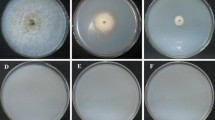Abstract
Transfer DNA (T-DNA) insertion mutants are often used in forward and reverse genetics to reveal the molecular mechanisms of a particular biological process in plants. To generate T-DNA insertion mutants, T-DNA must be inserted randomly in the genome through transformation mediated by Agrobacterium tumefaciens. During generation of a T-DNA insertion mutant, Agrobacterium competent cells are first prepared and plasmids containing the T-DNA introduced into Agrobacterium cells. Agrobacterium containing T-DNA vectors are then used to transform T-DNA into Arabidopsis. After screening and identifying T-DNA insertion mutants with interesting phenotypes, genomic DNA is extracted from the mutants and used to isolate the T-DNA flanking sequences. To finally determine the mutated genes causing the specific phenotype in the T-DNA insertion mutants, cosegregation analysis and complementation or recapitulation analysis are needed. In this chapter, we describe detailed protocols for generation and characterization of T-DNA insertion mutants.
Access this chapter
Tax calculation will be finalised at checkout
Purchases are for personal use only
Similar content being viewed by others
References
Krysan PJ, Young JC, Sussman MR (1999) T-DNA as an insertional mutagen in Arabidopsis. Plant Cell 11:2283–2290
Wilson RN, Somerville CR (1995) Phenotypic suppression of the gibberellin-insensitive mutant (gai) of Arabidopsis. Plant Physiol 108:495–502
Weigel D et al (2000) Activation tagging in Arabidopsis. Plant Physiol 122:1003–1013
Engineer CB et al (2005) Development and evaluation of a Gal4-mediated LUC/GFP/GUS enhancer trap system in Arabidopsis. BMC Plant Biol 5:9
Radhamony RN, Prasad AM, Srinivasan R (2005) T-DNA insertional mutagenesis in Arabidopsis: a tool for functional genomics. Electron J Biotechnol 8:82–106
Mattanovich D et al (1989) Efficient transformation of Agrobacterium spp. by electroporation. Nucleic Acids Res 17:6747
Shen WJ, Forde BG (1989) Efficient transformation of Agrobacterium spp. by high voltage electroporation. Nucleic Acids Res 17:8385
Clough SJ, Bent AF (1998) Floral dip: a simplified method for Agrobacterium-mediated transformation of Arabidopsis thaliana. Plant J 16:735–743
Clough SJ (2005) Floral dip: Agrobacterium-mediated germ line transformation. Methods Mol Biol 286:91–102
Bent AF (2006) Arabidopsis thaliana floral dip transformation method. Methods Mol Biol 343:87–103
Zhang X et al (2006) Agrobacterium-mediated transformation of Arabidopsis thaliana using the floral dip method. Nat Protoc 1:641–646
Clarke JD (2009) Cetyltrimethyl ammonium bromide (CTAB) DNA miniprep for plant DNA isolation. Cold Spring Harb Protoc 2009, pdb prot. 5177. doi:10.1101/pdb.prot5177
Liu YG, Huang N (1998) Efficient amplification of insert end sequences from bacterial artificial chromosome clones by thermal asymmetric interlaced PCR. Plant Mol Biol Rep 16:175–181
Liu YG et al (1995) Efficient isolation and mapping of Arabidopsis thaliana T-DNA insert junctions by thermal asymmetric interlaced PCR. Plant J 8:457–463
Liu YG, Whittier RF (1995) Thermal asymmetric interlaced PCR-automatable amplification and sequencing of insert end fragments from P1 and YAC clones for chromosome walking. Genomics 25:674–681
Qin G et al (2005) An indole-3-acetic acid carboxyl methyltransferase regulates Arabidopsis leaf development. Plant Cell 17:2693–2704
Qin G et al (2007) Arabidopsis AtBECLIN 1/AtAtg6/AtVps30 is essential for pollen germination and plant development. Cell Res 17:249–263
Author information
Authors and Affiliations
Editor information
Editors and Affiliations
Rights and permissions
Copyright information
© 2014 Springer Science+Business Media New York
About this protocol
Cite this protocol
Qu, LJ., Qin, G. (2014). Generation and Characterization of Arabidopsis T-DNA Insertion Mutants. In: Sanchez-Serrano, J., Salinas, J. (eds) Arabidopsis Protocols. Methods in Molecular Biology, vol 1062. Humana Press, Totowa, NJ. https://doi.org/10.1007/978-1-62703-580-4_13
Download citation
DOI: https://doi.org/10.1007/978-1-62703-580-4_13
Published:
Publisher Name: Humana Press, Totowa, NJ
Print ISBN: 978-1-62703-579-8
Online ISBN: 978-1-62703-580-4
eBook Packages: Springer Protocols




